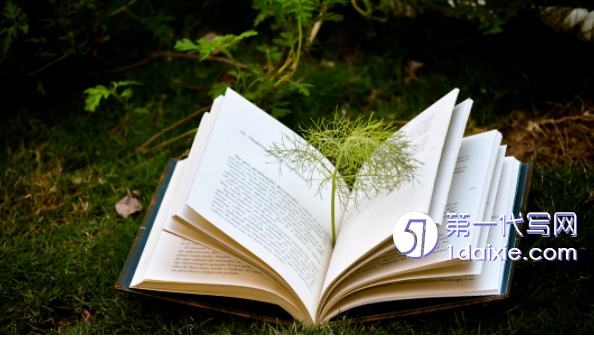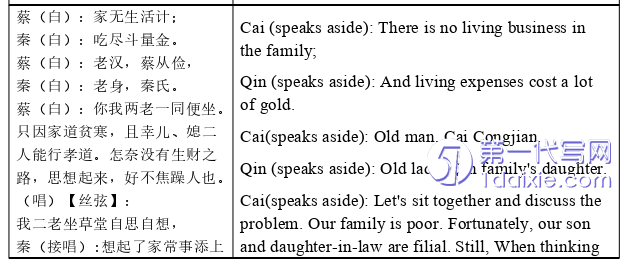本文是一篇英语毕业论文,本次翻译实践还涉及到跨学科知识和专业知识的结合。因为本翻译实践的语料文本其独特的风格,包含了大量的戏剧行话和术语,而具有较强的跨学科性和专业性,这给学科或专业之外的译者甚至读者形成了理解困难。
Chapter One Introduction
1.1 Background of the Project
With the deepening development of globalization,China's international statusand cultural soft power are increasingly improving.More and more Western countriesare eager to understand Chinese culture and strengthen their communication withChina.Driven by the trend of this era,opera classics,as the quintessence of Chineseculture,its translation becomes a good representative of cross-culturalcommunication.
However,the translation of opera is different from that of other genres’translations because the profound cultural heritage and rich forms of expression oftraditional Chinese opera make it a unique art genre.Its translation must take intoaccount the actual performance,which means the words used in the dialogue shouldbe easy to understand,the style should be colloquial,and the sentence structureshould not be too complex when a Chinese opera is translated into other languages.Therefore,in this process,the translators will be the key to the successful realizationof cross-cultural communication in spreading traditional Chinese opera.The creativityof translators in interpreting translation activities from a new perspective of purpose isobvious.Through diversified translation methods,it is beneficial for translators toexert their creativity,achieve accurate goals,and have a clear purpose.Only by doingso can we open up our brilliant treasure house of opera art to the world and betterdisseminate Chinese culture.

1.2 Significance of the Project
Chinese classical opera is a unique art that combines literature,music,dance,performance,martial arts,acrobatics,and other arts.It has the characteristics of bothrefined and popular tastes.Its“going-out”should not only be limited to thedissemination of desk literature but also be lively in stage performances.Excellenttheoretical guidance plays an important role in whether Chinese opera can open thecultural dialogue channel with the world.In this discourse environment,conductingthis translation practice has the following significance.
First of all,the book“Charm of Guangxi Wenchang Opera”has not yet beentranslated into Chinese,and the Guangxi Wenchang Opera involved in the text is oneof the forms of folk art of the type of oratorio.It was listed in the national intangiblecultural heritage list in 2008,and is regarded as the living fossil of Chinese ancientsongs and lyrics,enjoying the reputation of“a pearl in the treasure house of folk art”.Therefore,translating the text has a certain translation value.
Secondly,the excerpt of translation mainly takes the opera of“Story of the Pipa”as an analysis case,adopts the Skopos theory as the guiding theory,analyzes theperformance characteristics of the external translation of opera,and gives specifictranslation strategies,which can promote the better development of traditional operatranslation.
Chapter Two Translation Process
2.1 Pre-translation
To better complete the translation task,the author has done a lot of preparatorywork.The main tasks of this stage are to study the source text,verify relevantdocuments,learn relevant strategies,and prepare translation tools.
First of all,the author studies the source text repeatedly,trying to betterunderstand the content of the article and clarify the meaning of the text.When readingthe source text for the first time,sort out the plots of the text and understand thesentence characteristics and writing style.The source text is based on the ten folds of“Story of the Pipa”,including Guangcai Presented with the Gold,Wuniang Cuts HerHair,Cover the Earth on the Tomb Terrace,Bojie Misses His Hometown,WuniangGoes to the Capital,Amitabha's Enlightenment,Lady Niu Interrogates Her Husband,The Couple Meet in the Capital,Guangcai Sweeps the Pine Branches,EngravedGravestone,and Three Beats.The story is advancing layer by layer and is fascinating.Through the first reading,the author has a basic understanding of the story outline ofthe text.The second time when the author repeatedly read the source text,the authorlooked up relevant materials to comprehend the culture-loaded words and professionalterms of opera,and given that some opera terms are too obscure to understand,theauthor also visited the inheritor of Guangxi Wenchang Opera,Mrs.Lu Xubing,andthen experienced relevant operas on the spot,and asked her for professional advice onthe opera terms to learn their connotations.
2.2 While-translation
In the process of translation,the author summarizes the words and characters ofopera in the source text for reference.After breaking through the vocabulary problem,the author began to organize the translation,mark the difficult points in the translation,and make sufficient preparation for the case analysis of this report.
2.2.1 Difficulties in Translation
In the process of translating the first draft of the translation,some problems werefound at the level of words,sentences,and texts.
(1)First of all,at the lexical level,because the opera text has a large number ofChinese culture-loaded words and professional terms of opera,the author needs to bequite familiar with Chinese culture,opera culture,Guangxi Wenchang opera cultureand understand its connotation,which requires the author to carry out a large numberof data.
(2)Secondly,in terms of syntactic level,because Chinese pays attention toparataxis,while English pays attention to hypotaxis,Chinese often has manymeaningless modifiers for the needs of modification and tone,while English avoidssynonymous repetition and stresses conciseness.In the process of translation of operatexts,it is necessary to understand the meaning of the source text from the logic of Chinese,and then it is necessary to further understand the grammatical context fromthe perspective of English.
Chapter Three Theoretical Framework .............................. 8
3.1 Introduction to Skopos Theory .............................. 8
3.2 Application of Skopos Theory .......................... 9
Chapter Four Case Analysis .................................... 11
4.1 Skopos Rule Applied in Translation ............................. 11
4.1.1 Literal Translation ........................ 11
4.1.2 Free Translation ......................................... 12
Chapter Five Conclusion ........................... 19
5.1 Gains ....................... 19
5.2 Limitations ............................................ 20
Chapter Four Case Analysis
4.1 Skopos Rule Applied in Translation
Since Cicero first put forward the translation of“as an interpreter”and“as anorator”,there have been endless discussions about literal translation and freetranslation between China and the West(Li,2020).Here,the author can under theguidance of the Skopos rule,use appropriate translation strategies,such as literaltranslation,and free translation to translate closer to the source text.
4.1.1 Literal Translation
In this report,the author tries to retain the traditional cultural images of thesource text,so chooses to ensure the literal translation is feasible in the Englishtranslation of opera text and makes the translation retain the cultural characteristics ofthe source language to the greatest extent.The Skopos rule refers to the flexible use ofliteral translation to translate opera on the premise that the translation is faithful to thesource text.

Chapter Five Conclusion
5.1 Gains
First of all,it is necessary to do a good job of translation preparation,obtain thetranslation corpus,and not blindly translate immediately.Only by having a certainunderstanding of the source text can a better translation be presented.And the authoralso realized that during the translation process,translators should be good at usingtranslation tools and reference documents to understand relevant backgroundknowledge and organize special words appearing in the text so that the translatedversion can be accurate and efficient.
In addition,in the process of translation,it is necessary to combine the context ofthe source text for translation,and it should not be preconceived.Attention should bepaid to the issue of polysemy of a word.Sometimes,to write smoothly,it is alsonecessary to translate into the extended meaning of the source text.And the authoralso summarized the selection criteria of how to translate the cultural words.
(1)simplicity is the key.If we can find similar expressions in the target languagewithout effecting the main idea of the source text,such as“黉门”and“高魁”,thenwith the highest priority to imitation,we choose the equivalent expressions.
(2)For the sake of aesthetics,there are some terms that may need to involve morehistorical knowledge frameworks and even we can explain them,we can not help thereaders perfectly understand them,such as“三台”and“千钟”,then we can apply freetranslation to translate them.
(3)There are also some cultural words that are suitable for reflecting Chineseculture,such as“桑麻”,and literal translation can be considered,because there nosimilar activities in ancient foreign countries.
reference(omitted)
